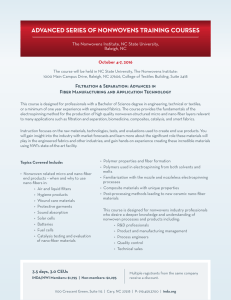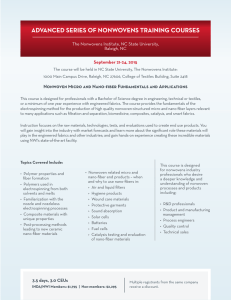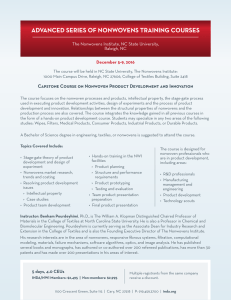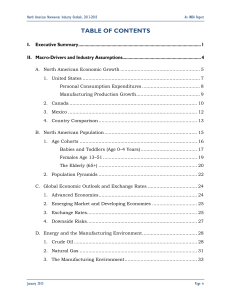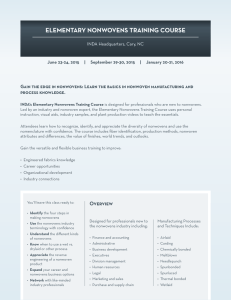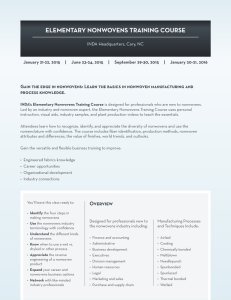Study on melt-blown polymer matrices – for technical and medical
advertisement
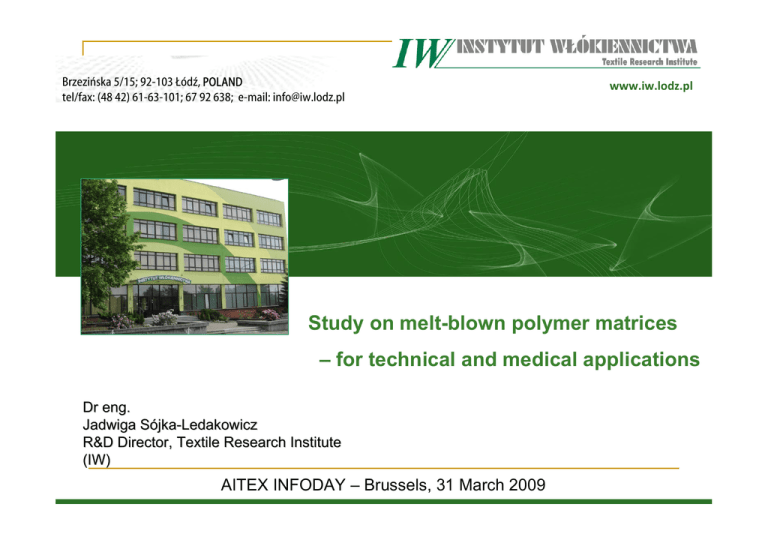
Brzezińska 5/15; 92-103 Łódź, POLAND tel/fax: (48 42) 61-63-101; 67 92 638; e-mail: info@iw.lodz.pl www.iw.lodz.pl Study on melt-blown polymer matrices – for technical and medical applications Dr eng. Jadwiga Sójka-Ledakowicz R&D Director, Textile Research Institute (IW) AITEX INFODAY – Brussels, 31 March 2009 www.iw.lodz.pl IW R&D works in the area of : material engineering – new, special high-tech textiles of barrier properties against UV and electromagnetic fields radiation, functional added value textiles and smart textiles polymers – melt blow technique, textile chemistry, nano- and micro-technology, environment protection – integrated methods of watewater treatment, water and energy reuse biotechnology - enzymes application in textiles processing, textile techniques and technologies. R&D works scope AITEX INFODAY – Brussels, 31 March 2009 www.iw.lodz.pl Currently IW employs 283 persons, it has suitable human resources and equipment: 995 research workers 9 5 Scientific Divisions 9 6 Testing Laboratories (5 accredited) 9 Institute is the notified body within 3 EU Directives: 88/378/EEC/ The Directive on the Safety of Toys, 89/686/EEC/ The Directive on Personal Protective Equipment (PPE) 93/42/EEC/ The Directive on medical devices IW Potential Method of obtaining composite polymer matrices according to melt-blow technique This integrated technique consists in linking fibre-forming process with web-forming process. The strings of molten polymer are blown up by the stream of hot compressed air. Molten polymer comes out form extruder head through the multihole nozzle and sets – as a fine fibre – on a collecting drum. AITEX INFODAY – Brussels, 31 March 2009 Melt-blowing process - scheme AITEX INFODAY – Brussels, 31 March 2009 Melt-blowing process stages - scheme Thermoplastic polymer (granulate): polypropylene, polyethylene polyamide, polycarbonate, polyester, copolymers, etc. Speed Temperature Pressure Additives Melting and homogenisation Filtration Pressure Dosing (dosing pump) Speed Temperature Pressure Dosing rate Polymer extrusion through nozzle Fibre formation Polymer extrusion through nozzle Formation of end product AITEX INFODAY – Brussels, 31 March 2009 Melt-blowing process The following factors have the influence on the meltblowing process and the properties of end-products: - polymer type, - process temperature, - the ratio of the hot air mass input to the polymer mass (technological parameters of the process), - the method of collecting formed web. AITEX INFODAY – Brussels, 31 March 2009 Melt-blown products testing Characteristics of polymer matrices: - average molecular mass, - range of melting temperatures, - viscosity in molten phase, - thermal stability, - glass transition temperature, - measurement of specific surface area and porosity, - gas and liquid vapours sorption analysis. AITEX INFODAY – Brussels, 31 March 2009 Melt-blown products testing Degradable polymers can degrade in natural environment as an effect of different factors: temperature, different types of chemical compounds, enzymes produced by micro-organisms as well as light, especially UV radiation. Degradation of polymer matrices – tests on: photodegradation (UV radiation) thermal degradation AITEX INFODAY – Brussels, 31 March 2009 Melt-blown nonwovens and products made of such nonwovens Melt-blow nonwovens and products made of such nonwovens form a group of textiles having many applicational possibilities. BIODEGRADABLE and ENVIRONMENTALLY FRIENDLY NONWOVENS CAN BE USED IN : MEDICINE TECHNICAL AREA AGRICULTURE / FARMING AITEX INFODAY – Brussels, 31 March 2009 Melt-blown nonwovens in medical applications Research works carried our by IW aim at the development of unique, multifunctional wound covering materials based on melt-blow nonwovens made of biodegradable polymers modified by biologically active compounds – chitosan, or other substances of good sorption properties towards toxins – active carbon. Developed product after suitable pharmacological testing and after formal registration (according to official regulations) could be used as wound covering material for outer and inner application. AITEX INFODAY – Brussels, 31 March 2009 Melt-blown nonwoven with active carbon active carbon AITEX INFODAY – Brussels, 31 March 2009 Melt-blown nonwovens with chitosan of microbiological origin Recent research works carried by IW concern the application of chitosan of microbiological origin, isolated from from Absidia type fungi. Such chitosan is introduced at the stage of forming melt-blown fibres. Melt-blown nonwovens with chitosan of microbiological origin Due to specific chemical, molecular and biological properties Chitosan (poly(2-deoxy-2-aminoglucose)) is an example of a polymer having wide applicational range. Micro-crystalic chitosan has many functional properties: high value of swelling coefficient, ability to form polymer films directly from suspensions, bioactivity, especially high tenacity / adhesion, controllable antibacterial activity, non-toxicity, high stability, good miscibillity with a range of substances including polymers, high level of chemical reactivity, high sorption capability. Melt-blown nonwovens in technical applications - environment protection Special focus should be on nonwovens based on superfine fibres, the diameter in the range of 0,5 – 5 µm, used for high performance materials for gas (dry filtration) and liquid filtration (wet filtration). On the basis of highly efficient filtering nonwovens the following product were developed: aspirator filters, used in industrial dust measuring, filtrating-sorptive structures for simultaneous air cleaning from toxic dusts and gases. Melt-blown nonwovens with average fibre diameter ca. 2 µm can filtrate impurities - particles from atmospheric aerosols in the range of 27 ÷ 274 nm. AITEX INFODAY – Brussels, 31 March 2009 Melt-blown nonwovens in technical applications - environment protection Method of filtrating liquid medium and laminar filtrating-sorptive structure for filtering liquid medium, especially oiled medium. Figure – Pack scheme 1. Melt-blow nonwoven with developed surface 2. Bulky PP nonwoven 3.and 4. Joinings A method of filtrating liquid media and a filtrating –sorptive pack for filtrating liquid medium, especially oiled medium. Such a pack should be installed in filtrating chamber of gravity – slow-rate and high-rate filters in water purification plants and in wastewater treatment plants. AITEX INFODAY – Brussels, 31 March 2009 Melt-blown nonwovens in technical applications - environment protection Products absorbing oil-like substances MATS removing impurities from hardened surfaces, removal of spills, cleaning of industrial installations Application: petrol stations, parkings, road surfaces, car service stations, assembly rooms, industrial areas PILLOWS removal of impurities from water surface, absorbing large volume spills from hardened surfaces SLEEVES limiting the spills spreading in water regions, absorbing spills on hardened surfaces AITEX INFODAY – Brussels, 31 March 2009 Current r&d works carried out by IW Project ordered by the Polish Ministry of Science and Higher Education no. PBZ-MNiSW-01/II/2007 Biodegradable nonwovens to be applied in medicine, agriculture and technics tasks: Development of composite nonwoven matrices for technical applications Study on surface properties of biodegradable nonwovens to be applied in medicine, agriculture and technics Contact: Textile Research Institute (IW) , Brzezińska 5/15, 92-103 Łódź, POLAND tel + 4842 6163 180; fax + 4842 67-92-638 e-mail: ledakowicz@iw.lodz.pl AITEX INFODAY – Brussels, 31 March 2009
